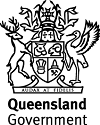Published Sunday, 18 May, 2008 at 06:00 PM

Minister for Primary Industries and Fisheries
The Honourable Tim Mulherin
Man’s best friend deserves more ute safety
That great Aussie icon - the dog in the back of the ute - is at great risk because they often travel unrestrained in vehicles
Minister for Primary Industries and Fisheries Tim Mulherin said thousands of dogs were injured each year because owners did not tether them safely.
“Dogs can be unpredictable, over balance, fall out and be dragged along the side of the vehicle, the Minister said.
“Many owners do recognise the dangers and act responsibly, however, if dogs are not properly restrained they can be struck by overhanging tree branches, try to jump from the vehicle and be struck by passing vehicles.”
The Minister said to promote dog welfare and safety when travelling in utility vehicles, DPI&F had issued a new brochure Dogs in Utes.
“The brochure is an easy-to-read, quick reference guide to make dog owners more aware of their responsibilities and advise them on how best to restrain their beloved animals in the back of utes or open trays,” he said.
“The brochure has colour illustrations complementing the text to demonstrate commonsense solutions to avoid such incidents and injuries.”
DPI&F Animal Welfare regional project leader Ian Rodger said the best protection was to put the dog in a sheltered cage, or tether it to the middle of the tray just behind the cabin with a leash long enough to allow it to move about comfortably but short enough to prevent it from reaching the ute’s side.
“Avoid choker chains that can strangle the dog when the vehicle brakes suddenly,” he said.
“The best method of tethering is a properly fitted harness with swivels at both ends to prevent entanglement.”
He warned that metal trays could heat up quickly and burn the dog’s paws, and recommended a protective surface such as rubber matting was placed under the dog.
“The Animal Care and Protection Act 2001 places a legal duty of care on any person in charge of a dog travelling in the back of a ute or open tray,” Mr Rodger said.
“It is an offence to breach that duty of care and stiff fines can result for people who fail to take the proper precautions in ensuring a dog travels safely.
The brochure is a useful tool for recreational hunters, hobby farmers, producers with working dogs and families with pets.
The Dogs in Utes brochure is available at DPI&F offices and on the DPI&F website at www.dpi.qld.gov.au.
Media: 3239 3120
Minister for Primary Industries and Fisheries Tim Mulherin said thousands of dogs were injured each year because owners did not tether them safely.
“Dogs can be unpredictable, over balance, fall out and be dragged along the side of the vehicle, the Minister said.
“Many owners do recognise the dangers and act responsibly, however, if dogs are not properly restrained they can be struck by overhanging tree branches, try to jump from the vehicle and be struck by passing vehicles.”
The Minister said to promote dog welfare and safety when travelling in utility vehicles, DPI&F had issued a new brochure Dogs in Utes.
“The brochure is an easy-to-read, quick reference guide to make dog owners more aware of their responsibilities and advise them on how best to restrain their beloved animals in the back of utes or open trays,” he said.
“The brochure has colour illustrations complementing the text to demonstrate commonsense solutions to avoid such incidents and injuries.”
DPI&F Animal Welfare regional project leader Ian Rodger said the best protection was to put the dog in a sheltered cage, or tether it to the middle of the tray just behind the cabin with a leash long enough to allow it to move about comfortably but short enough to prevent it from reaching the ute’s side.
“Avoid choker chains that can strangle the dog when the vehicle brakes suddenly,” he said.
“The best method of tethering is a properly fitted harness with swivels at both ends to prevent entanglement.”
He warned that metal trays could heat up quickly and burn the dog’s paws, and recommended a protective surface such as rubber matting was placed under the dog.
“The Animal Care and Protection Act 2001 places a legal duty of care on any person in charge of a dog travelling in the back of a ute or open tray,” Mr Rodger said.
“It is an offence to breach that duty of care and stiff fines can result for people who fail to take the proper precautions in ensuring a dog travels safely.
The brochure is a useful tool for recreational hunters, hobby farmers, producers with working dogs and families with pets.
The Dogs in Utes brochure is available at DPI&F offices and on the DPI&F website at www.dpi.qld.gov.au.
Media: 3239 3120

